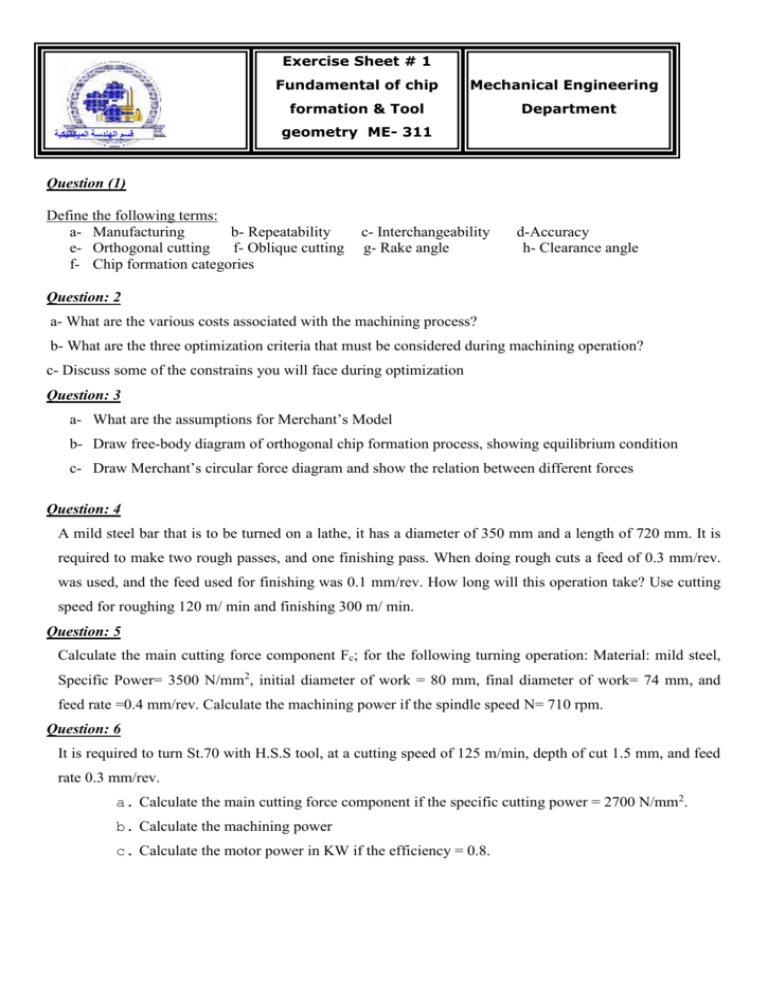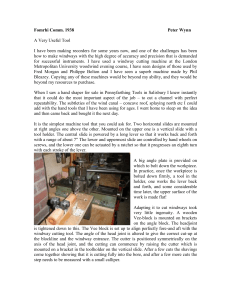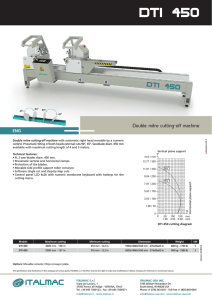Sheets
advertisement

Exercise Sheet # 1 Fundamental of chip Mechanical Engineering formation & Tool قسم الهندسة الميكانيكية Department geometry ME- 311 Question (1) Define the following terms: a- Manufacturing b- Repeatability e- Orthogonal cutting f- Oblique cutting f- Chip formation categories c- Interchangeability g- Rake angle d-Accuracy h- Clearance angle Question: 2 a- What are the various costs associated with the machining process? b- What are the three optimization criteria that must be considered during machining operation? c- Discuss some of the constrains you will face during optimization Question: 3 a- What are the assumptions for Merchant’s Model b- Draw free-body diagram of orthogonal chip formation process, showing equilibrium condition c- Draw Merchant’s circular force diagram and show the relation between different forces Question: 4 A mild steel bar that is to be turned on a lathe, it has a diameter of 350 mm and a length of 720 mm. It is required to make two rough passes, and one finishing pass. When doing rough cuts a feed of 0.3 mm/rev. was used, and the feed used for finishing was 0.1 mm/rev. How long will this operation take? Use cutting speed for roughing 120 m/ min and finishing 300 m/ min. Question: 5 Calculate the main cutting force component Fc; for the following turning operation: Material: mild steel, Specific Power= 3500 N/mm2, initial diameter of work = 80 mm, final diameter of work= 74 mm, and feed rate =0.4 mm/rev. Calculate the machining power if the spindle speed N= 710 rpm. Question: 6 It is required to turn St.70 with H.S.S tool, at a cutting speed of 125 m/min, depth of cut 1.5 mm, and feed rate 0.3 mm/rev. a. Calculate the main cutting force component if the specific cutting power = 2700 N/mm2. b. Calculate the machining power c. Calculate the motor power in KW if the efficiency = 0.8. Exercise Sheet # 2 Fundamental of chip formulation & Tool life قسم الهندسة الميكانيكية Mechanical Engineering Department ME- 311 Question: 1 1234567- State the conditions which have an important influence on the metal cutting process. State the important characteristics expected of cutting tool materials. State the different materials used for manufacturing cutting tools. State the requirements when machining with ceramics State the measurable quantities of the tool life State the factors effect on the obtained surface finish State the specifications of the cutting fluid Question: 2 In a laboratory test on turning operation, the following data have been recorded at a depth of cut 4 mm: cutting speed tool life feed m/mn min mm/rev 100 120 0.10 130 50 0.10 100 70 0.12 a tool life equation is to deduced by a computing the values of x, y, z in the relationship (where C =3.25). V Tx f y dz = C Question: 3 In an experiment to measure the tool life at different cutting speeds, the following results were obtained: V (m/min) 100 120 T (min) 60 48 Using Taylor’s equation, find the expected tool life at a cutting velocity of 85 m/min. Question: 4 The life of a cutting tool is 40 min at cutting speed 120 m/min and 130 min at a cutting speed of 40 m/min. Calculate: a- The value of Taylor exponent n and the constant C b- Tool life if V = 70 m/min. c- The necessary speed for a tool life of 3 hours. Exercise Sheet # 3 Milling Mechanical Engineering ME- 311 Department قسم الهندسة الميكانيكية 1- Draw the configuration diagram for a horizontal milling machine showing all constructional features. 2- State at least five different types of milling machines. 3- Define some of tools used on milling machines. 4- Compare between up milling and down milling 5- A slab- milling operation is performed on the surface of a rectangular work piece 300 mm long by 100 mm wide. The milling cutter is 75 mm diameter and has 4 teeth, overhangs the width of the part on both sides. The cutting conditions are; cutting speed= 80 m/min, feed= 0.2 mm/tooth and depth of cut= 7.0 mm. Determine: a) Arbor rotational speed. b) The time required to make one pass across the surface and, c) The material removal rate within the cut. 6- In horizontal milling operation, if the: Cutter diameter = 100 mm, Number of teeth = 8 teeth, Cutting speed = 15 m/min, Table feed = 320 mm/min, and Depth of cut = 4 mm. Calculate the maximum chip thickness. 7- A slab-milling operation is being carried out on a 500 mm long, 230 mm wide carbon steel block at a feed 0.25 mm/ tooth and a depth of cut 3 mm. The cutter is 50 mm in diameter, has 10 straight teeth, rotates at 100 r.p.m., and is wider than the block to be machined. Calculate the material removal rate, estimate the power. Take the specific cutting pressure = 370 kg/mm2. 8- Determine the power required for the following slab milling operation: (Use specific cutting pressure = 300 kg /mm square) -Work material soft steel - Cutter diameter 75 mm - No. of teeth 8 - Cutting speed 25 m/min - Feed 75 mm/min - Width of cut 100 mm - Depth of cut 5 mm Exercise Sheet # 4 DRILLING Mechanical Engineering Department قسم الهندسة الميكانيكية ME- 311 9- In a drilling process using a twist drill, the tip angle the spindle rotational speed is 400 rpm., the feed rate is rev. and the hole diameter is 15 mm. Calculate: iThe machining time to drill a through hole in a thickness 25 mm. ii- The amount of material removed during the first after the drill’s full engagement. iii- The drilling torque if the specific cutting energy piece material equals 1200 N/mm2. iv- The cutting power. is 120, 0.3 mm / plate of 10 sec. for work 10In a through drilling operation, the diameter of the twist drill is 10 mm, and its point angle is 120°. The spindle speed is set to 600 rpm and the feed rate is set to 60 mm/min. The material of the work piece is steel 1020 with an average specific cutting resistance of 2000 N/mm2, having a thickness of 20 mm. Calculate the cutting torque, total cutting power and the machining time. Drilling allowance is 5 mm. 11In a through drilling operation of Aluminium work piece, the point angel of the twist drill is 120°. The main cutting power is 500 Watt. The spindle speed is set to 1200 rpm and the feed rate is set to 80 mm/min. The specific cutting energy of the Aluminium is 700 N/mm2. Calculate the diameter of the twist drill. 12Calculate the cutting power, feed power and material removal rate for the following drilling operation: Material: Mild Steel Mean specific cutting resistance: 3500 N/mm2 Diameter of twist drill: 20 mm Feed rate: 60 mm/min Spindle speed: 600 rpm 1- In an experiment to measure the tool life at different cutting speeds, the following results were obtained: V (m/min) 100 120 T (min) 60 48 Using Taylor’s equation, find the expected tool life at a cutting velocity of 85 m/min. 2. The life of a cutting tool is 40 min at cutting speed 120 m/min and 130 min at a cutting speed of 40 m/min, calculate: a- The value of Taylor exponent n and the constant C. b- Tool life if V = 70 m/min. c- The necessary speed for a tool life of 3 hours. 3. In a production turning operation, the work piece is 125 mm in diameter and 300 mm long. A feed rate of 0.225 mm/ rev is used. If the cutting speed was 3.0 m/s, the tool must be changed every 5 parts; but if reducing speed to 2 m/s, the tool produces 25 parts between tool changes or re-sharpening. Determine the Taylor tool life equation for this job. 4. Durability tests on a tool have given the following results when the other parameters of test are constant V m/min 40 80 120 T min 130 46 25 Calculate: a- Value of Taylor exponent n analytically and check the results graphically. b- Value of the constant C in the relation. c- Value of the cutting speed corresponding to the durability 360 min, 60 min and 30 min. 7. A lathe running at a speed of 4000 rpm is cutting Mild Steel with a H.S.S. tool. The spindle speed is reduced to 3000 rpm. Calculate the percentage change in tool life if n = 0.125. Exercise Sheet # 5 MILLING Mechanical Engineering Department قسم الهندسة الميكانيكية ME- 311 1. A slab- milling operation is performed on the surface of a rectangular work piece 300 mm long by 100 mm wide. The milling cutter is 75 mm diameter and has 4 teeth, overhangs the width of the part on both sides. The cutting conditions are; cutting speed= 80 m/min, feed= 0.2 mm/tooth and depth of cut= 7.0 mm. Determine: a) Arbor rotational speed. b) The time required to make one pass across the surface and, c) The material removal rate within the cut. 2. In horizontal milling operation, if the: Cutter diameter = 100 mm, Number of teeth = 8 teeth, Cutting speed = 15 m/min, Table feed = 320 mm/min, and Depth of cut = 4 mm. Calculate the maximum chip thickness. 3. A slab-milling operation is being carried out on a 500 mm long, 230 mm wide carbon steel block at a feed 0.25 mm/ tooth and a depth of cut 3 mm. The cutter is 50 mm in diameter, has 20 straight teeth, rotates at 100 r.p.m., and is wider than the block to be machined. Calculate the material removal rate, estimate the power and torque required for this operation, maximum chip thickness and calculate the cutting time. Take the specific cutting energy 3.7 W. s/ mm3. 4. A 3 KW horizontal milling machine is used to reduce the height of a slab work piece to 60 mm. The thickness and width of the work piece are 120 mm. The length of the work piece 300 mm and the cutter has 4 teeth. The width and diameter of the cutter are 150 and 40 mm respectively. The spindle speed is set to 1200 RPM. The feed per tooth is 0.1 mm. Calculate the metal removal rate and the machining time per pass (over travel is 2 mm and maximum depth of cut is 5 mm). Are these cutting conditions suitable for this machine? Why? 4- Calculate the machine tool spindle speed for turning on a lathe with a high speed steel tool in mild steel work with a diameter of 70 mm. The cutting speed is 30 m/min. 1. A shaper tool, making an orthogonal cut, has a 10° rake angle. The depth of cut is 0.6 mm, the width of cut 3 mm and the cutting speed is 40 m/min. Two components dynamometer is used to determine the main cutting force which gave 3600 N, and normal thrust component 2400 N. A high speed photograph shows a shear plane angle of 20°. Calculate: a. The expected chip thickness. b. The shearing stress on the shear plane. c. The machining power. d. Total specific energy. 2. An orthogonal cut 3.0 mm wide is made at a speed of 45 m/min and a feed rate of 0.25 mm/rev with a high-speed steel tool having a 15° rake angle. The chip thickness ratio is found to be 0.58, the main cutting force is 1000 N and the normal thrust force is 280 N. Calculate: a. Chip thickness b. Resultant cutting force c. Shear plane angle d. Machining power 3. In tube turning operation, outer diameter = 50 mm, inner diameter = 45 mm, feed = 60 mm/min, chip thickness = 1 mm, linear cutting speed = 30 m/min, rake angle = 10°, main cutting force = 1000 N and thrust force component = 500 N. d. Calculate the shear angle e. Calculate the percentage of the total power that goes into overcoming friction at tool-chip interface. f. Calculate the percentage of the total power along shear plane. g. Mean shear stress. 4. In an orthogonal cutting operation, the tool has a rake angle = 15. The depth of cut is 0.3 mm and the deformed chip thickness is 0.65 mm. Calculate: a. the shear plane angle. b. the shear strain for the operation. 5. It is required to turn St.70 with H.S.S tool of a rake angle 15o, at a cutting speed of 25 m/min, depth of cut 1.5 mm, and feed rate 0.3 mm/rev. a. Calculate the main cutting force component if the specific cutting energy u = 2700 N/mm2. b. Calculate the machining power and motor power in KW if motor efficiency = 0.8 6.







